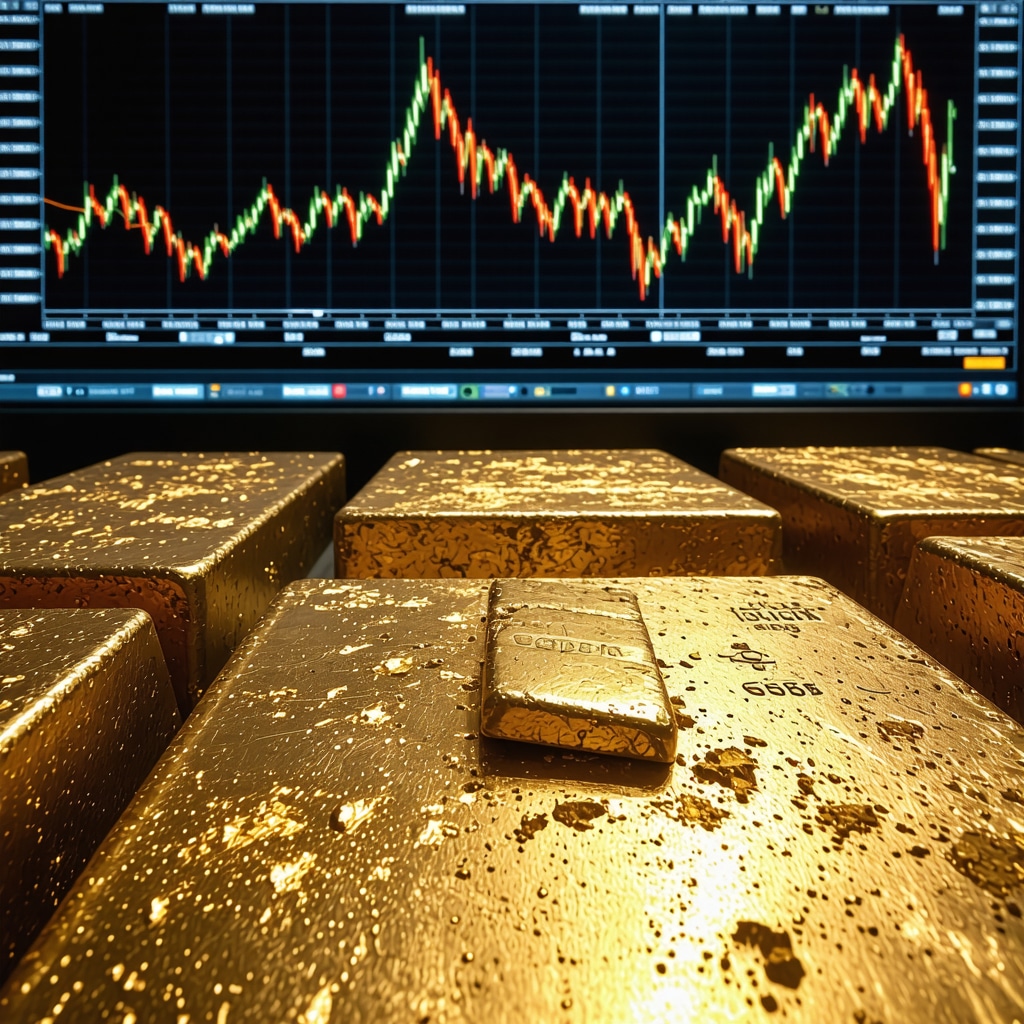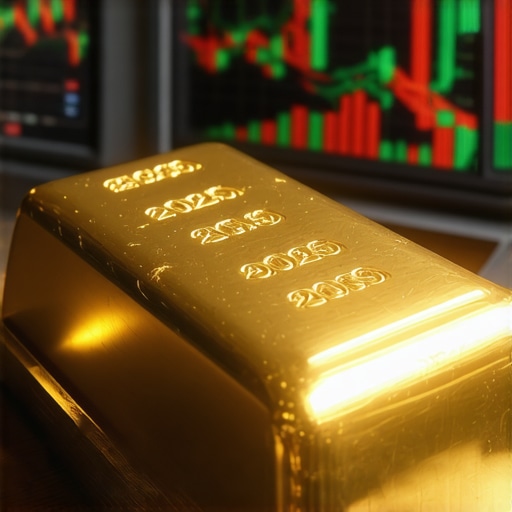Gold Futures as a Catalyst in Market Volatility Dynamics
In the complex ecosystem of global financial markets, gold futures play a pivotal role in shaping volatility patterns. These derivative instruments, representing contracts to buy or sell gold at predetermined prices and dates, function not only as hedging tools but also as speculative vehicles that can amplify or dampen market fluctuations. Their intrinsic leverage and sensitivity to geopolitical and economic variables position them as key influencers in the broader market’s ebb and flow.
Mechanisms Linking Gold Futures to Market Price Swings
Understanding the specific pathways through which gold futures impact market volatility requires an examination of their liquidity, trading volume, and inter-market connectivity. High liquidity in gold futures markets permits rapid price discovery but also introduces susceptibility to abrupt price movements when large positions are unwound. Additionally, the close correlation between gold prices and risk sentiment means that futures activity often mirrors or anticipates shifts in investor confidence, thereby transmitting volatility across asset classes.
How Do Gold Futures Trading Strategies Affect Volatility in Broader Financial Markets?
Expert traders employ sophisticated strategies such as spread trades, calendar spreads, and options overlay with gold futures to manage risk and exploit market inefficiencies. These strategies, while designed to mitigate individual exposure, cumulatively engender complex feedback loops that can exacerbate price swings. For instance, during periods of economic uncertainty, increased speculative activity in gold futures can lead to heightened volatility not only in gold but also in equities and currencies, reflecting gold’s role as a safe-haven asset.
Advanced Risk Management: Leveraging Gold Futures Amid Volatile Conditions
Institutional investors increasingly integrate gold futures into diversified portfolios to hedge against systemic risks and inflationary pressures. The adaptability of gold futures contracts allows for dynamic rebalancing in response to market signals, thereby offering a tactical edge in volatile environments. However, mastering these instruments demands a deep understanding of contract specifications, margin requirements, and the macroeconomic factors influencing gold demand.
Interpreting Market Signals Through Gold Futures Price Movements
The subtle variations in gold futures prices often serve as leading indicators of market sentiment shifts. For instance, a sustained rise in futures premiums may signal anticipated supply constraints or heightened geopolitical tensions, both of which typically increase volatility. Integrating such insights with comprehensive gold market analysis enhances an investor’s ability to anticipate and respond to market turbulence effectively.
For traders and investors seeking to deepen their expertise in this domain, exploring detailed strategies on profitably trading gold futures contracts offers valuable tactical knowledge.
External Reference: For a rigorous academic perspective on the role of gold futures in financial markets, see Baur, D. G., & Lucey, B. M. (2010). “Is Gold a Hedge or a Safe Haven? An Analysis of Stocks, Bonds and Gold” published in Journal of Banking & Finance, which provides empirical evidence on gold’s behavior during market stress.
Engage with our community of experts and share your insights on gold futures impact by visiting our specialized forum and accessing advanced content on mastering gold trading techniques.
Decoding the Feedback Loops Between Gold Futures and Market Volatility
Gold futures markets are not isolated; they influence and are influenced by various asset classes, creating feedback loops that can either escalate or dampen overall market volatility. When traders react to macroeconomic news or geopolitical events, their positions in gold futures can trigger cascading effects across equities, bonds, and currencies. This interconnectedness underscores the importance of understanding not just gold futures in isolation but their systemic role in global financial stability.
Moreover, algorithmic trading and high-frequency strategies have intensified the speed and magnitude of these feedback cycles. Automated systems capable of executing large gold futures trades based on market signals can inadvertently amplify price swings, especially during periods of heightened uncertainty. Analysts and portfolio managers must thus incorporate advanced modeling techniques to anticipate such nonlinear market responses.
Strategic Portfolio Diversification: Integrating Gold Futures with Other Asset Classes
Incorporating gold futures into a diversified portfolio offers a tactical advantage by providing a hedge against inflation and currency devaluation. Unlike physical gold, futures allow for leveraged exposure and greater liquidity, enabling investors to dynamically adjust their positions with precision. However, the correlation between gold futures and other assets can vary significantly, especially during market stress, necessitating continuous reassessment of portfolio composition.
Institutional investors often blend gold futures with equities, fixed income, and alternative investments to optimize risk-adjusted returns. The key lies in balancing exposure to gold futures with other inflation-sensitive assets and safe havens to achieve resilience against unexpected shocks. For further insights into building a balanced portfolio that leverages gold’s unique characteristics, consider exploring our comprehensive guide on gold vs stocks best strategies to balance your portfolio.
What Advanced Analytical Tools Can Enhance Predictive Accuracy in Gold Futures Trading?
Experts increasingly turn to sophisticated quantitative models such as machine learning algorithms, sentiment analysis, and volatility forecasting to anticipate gold futures price movements. These tools assimilate vast datasets—including macroeconomic indicators, geopolitical developments, and trading volumes—to generate predictive signals that inform tactical positioning.
Sentiment analysis, for instance, leverages natural language processing to gauge market mood from news feeds and social media, providing early warnings of volatility spikes. Simultaneously, volatility forecasting models like GARCH (Generalized Autoregressive Conditional Heteroskedasticity) help estimate future price variance, enabling traders to calibrate risk management strategies effectively.
The integration of these analytical frameworks fosters a multi-dimensional understanding of market dynamics, empowering traders and investors to navigate complex volatility landscapes with enhanced confidence.
Regulatory and Structural Factors Influencing Gold Futures Markets
Regulatory frameworks governing gold futures exchanges profoundly impact market behavior and volatility. Recent reforms aimed at enhancing transparency, margin requirements, and position limits seek to curtail excessive speculation while preserving market liquidity.
Structural elements such as contract specifications, delivery mechanisms, and clearinghouse protocols also shape trading dynamics. Changes in these parameters can alter trading strategies and risk profiles, thereby influencing price stability.
Staying abreast of regulatory developments and structural shifts is imperative for market participants who aim to optimize their engagement with gold futures markets. For a detailed examination of these aspects, visit our resource on gold futures explained and trading strategies for 2025.
External Reference: For an in-depth analysis of the interplay between gold futures market regulations and volatility, see Choi, S., & Lee, S. (2021). “Market Microstructure and Volatility in Gold Futures Markets,” published in Journal of International Money and Finance.
We invite you to share your perspectives and experiences on gold futures trading in our community forum, and don’t miss out on more expert insights by reading our latest articles on mastering gold trading techniques.
Gold Futures as a Barometer for Macroeconomic Uncertainty: Interpreting Complex Signals
The behavior of gold futures transcends simple price movements, serving as a dynamic barometer for macroeconomic uncertainties. Investors and economists alike scrutinize fluctuations in gold futures to infer market expectations about inflation trajectories, central bank policies, and geopolitical risks. For example, a persistent upward trend in gold futures prices often signals mounting inflation fears or currency debasement concerns, prompting shifts in broader asset allocations.
However, interpreting these signals requires nuanced understanding. Transient spikes may reflect short-lived geopolitical tensions, whereas sustained price increases often denote deeper systemic anxieties. Additionally, the interplay between U.S. dollar strength and gold futures further complicates this relationship, as a weaker dollar generally enhances gold’s appeal as an alternative store of value, impacting futures prices accordingly.
Can Gold Futures Predict Inflation Surges Better Than Traditional Indicators?
While traditional inflation gauges rely on lagging economic data, gold futures provide a forward-looking perspective that incorporates real-time market sentiment and geopolitical developments. Studies have demonstrated that incorporating gold futures prices into inflation forecasting models can improve predictive accuracy, especially during episodes of sudden policy shifts or unexpected economic shocks.
For instance, the National Bureau of Economic Research (NBER) highlights that gold prices—and by extension futures—serve as effective early-warning indicators for inflationary pressures, particularly in emerging markets vulnerable to currency volatility. This predictive capability is invaluable for portfolio managers aiming to preemptively adjust allocations to inflation-sensitive assets.
Algorithmic Trading in Gold Futures: Enhancing Market Efficiency or Amplifying Volatility?
Algorithmic trading has revolutionized gold futures markets by introducing ultra-fast execution and sophisticated pattern recognition, enabling traders to capitalize on fleeting arbitrage opportunities. These algorithms analyze multifaceted datasets, from order book imbalances to macroeconomic news feeds, executing trades within milliseconds.
Yet, this technological advancement is a double-edged sword. While algorithmic strategies enhance liquidity and market efficiency, they can also exacerbate volatility during market stress. Flash crashes and abrupt price reversals often trace back to automated trading systems triggering cascade reactions, especially in gold futures where leverage amplifies outcomes.
Market participants must therefore incorporate advanced risk controls and real-time monitoring to mitigate unintended consequences of algorithmic activity. Combining human oversight with machine intelligence emerges as the optimal approach for navigating these complex dynamics.
Gold Futures and Currency Markets: The Intricacies of Cross-Asset Volatility Transmission
The interdependence between gold futures and currency markets is profound, rooted in gold’s historical role as a currency hedge and reserve asset. Movements in major currencies—particularly the U.S. dollar, euro, and Chinese yuan—can trigger significant adjustments in gold futures prices.
Conversely, sharp price shifts in gold futures often influence currency valuations, especially in commodity-dependent economies. This bidirectional relationship creates intricate feedback loops where volatility in one market cascades into another, complicating risk management strategies.
Advanced cross-asset models leveraging co-integration and vector autoregression help quantify these transmission mechanisms, enabling traders to anticipate spillover effects and optimally hedge multi-asset exposures.
What Are the Best Practices for Integrating Gold Futures into Multi-Asset Volatility Hedging Frameworks?
Integrating gold futures into sophisticated hedging frameworks involves balancing their unique risk-return profile with correlated assets. Best practices include employing dynamic hedging strategies that adjust exposure based on real-time volatility metrics and market signals derived from both gold futures and related asset classes.
Moreover, incorporating scenario analysis and stress testing enhances resilience by simulating extreme market conditions where traditional correlations may break down. Risk managers must also consider liquidity constraints, margin volatility, and regulatory capital implications when deploying gold futures in comprehensive hedging programs.
For practitioners seeking to deepen their strategic toolkit, exploring detailed methodologies in our advanced hedging with gold futures series provides actionable insights.
External Reference: For a comprehensive examination of gold futures’ macroeconomic signaling and market integration, see Beckmann, J., Berger, T., & Czudaj, R. (2015). “Is gold a hedge or a safe haven? An analysis of stocks, bonds and gold,” published in Resources Policy, which elucidates gold’s multifaceted role amidst economic turbulence.
Deciphering Nonlinear Dynamics in Gold Futures Volatility Interactions
The multifaceted interactions between gold futures and global market volatility extend beyond linear cause-effect paradigms, necessitating the application of nonlinear dynamic systems theory. Market participants leveraging chaos theory and fractal market analysis reveal that gold futures price trajectories often exhibit fractal properties, which imply self-similarity across multiple time scales. Recognizing such patterns enables the anticipation of sudden regime shifts in volatility, which traditional linear models fail to detect adequately.
Moreover, the coupling of gold futures markets with macroeconomic shocks and investor behavioral biases produces emergent phenomena that challenge classical risk assessment frameworks. Incorporating these insights into portfolio optimization and risk management enhances robustness against unpredictable volatility spikes.
How Can Nonlinear Time Series Models Improve Forecasting Accuracy for Gold Futures Volatility?
Advanced quantitative analysts employ nonlinear time series methodologies such as Markov-switching models, regime-switching GARCH, and neural network-based forecasting to capture the complex stochastic behavior of gold futures volatility. These models accommodate abrupt structural breaks and regime changes, providing superior out-of-sample predictive performance compared to conventional approaches.
For instance, Markov-switching GARCH models dynamically identify volatility regimes—low, medium, and high—allowing traders to adapt risk exposure in real time. Similarly, deep learning architectures trained on high-frequency gold futures data extract latent nonlinear dependencies, facilitating preemptive positioning ahead of volatility surges.
Integrating these sophisticated tools into trading systems is pivotal for institutions seeking alpha in turbulent market environments and mitigating downside risks effectively.
Decoding the Impact of Geopolitical Event Clusters on Gold Futures Liquidity and Price Stability
Clusters of geopolitical events, such as simultaneous regional conflicts or overlapping economic sanctions, exert compounded effects on gold futures liquidity and price dynamics. This phenomenon induces liquidity fragmentation and escalates bid-ask spreads, destabilizing price discovery mechanisms. Such conditions disproportionately affect futures markets due to their leverage and margining structures.
Market microstructure research highlights that during these clustered events, market makers widen spreads and reduce inventory holdings, exacerbating volatility. Adaptive liquidity provision models and stress testing under clustered event scenarios are essential to anticipate and manage these liquidity shocks.
Understanding these dynamics enables risk managers and regulators to design more resilient trading infrastructures and contingency protocols tailored for gold futures markets during times of geopolitical turbulence.
Harnessing Blockchain and Distributed Ledger Technologies to Revolutionize Gold Futures Settlement and Transparency
Emerging applications of blockchain technology promise to transform gold futures markets by enhancing settlement efficiency and market transparency. Distributed ledger systems enable near-instantaneous clearing and settlement, reducing counterparty risk and operational latency inherent in traditional clearinghouses.
Beyond settlement, blockchain facilitates immutable audit trails for gold provenance and contract execution, fostering trust among market participants. Smart contracts automate margin calls and collateral management dynamically, aligning with real-time market conditions to mitigate systemic risks.
Industry pioneers are piloting blockchain-enabled gold futures platforms that integrate Internet of Things (IoT) data for physical gold verification, bridging digital contracts with tangible assets seamlessly.
What Are the Regulatory Challenges and Opportunities in Implementing Blockchain Solutions for Gold Futures Markets?
The adoption of blockchain in gold futures trading faces regulatory scrutiny related to jurisdictional compliance, data privacy, and systemic risk oversight. Regulators must balance innovation facilitation with safeguarding market integrity, necessitating frameworks that accommodate decentralized architectures without compromising transparency and consumer protection.
Opportunities lie in leveraging regulatory technology (RegTech) to automate compliance monitoring through smart contracts and real-time reporting, enhancing supervisory capabilities. Collaborative initiatives between exchanges, regulators, and technology providers are critical to developing interoperable standards and governance models for blockchain integration.
For an exhaustive exploration of these regulatory dimensions, the Bank for International Settlements (BIS) report on Distributed Ledger Technology in Financial Markets offers authoritative guidance on balancing innovation with prudential safeguards.
Engage with our advanced analysis and join the discourse on leveraging cutting-edge technologies and complex modeling techniques to master gold futures market volatility. Explore our specialist resources and community forums to deepen your expertise and strategic acumen.
Expert Insights & Advanced Considerations
1. The Systemic Influence of Gold Futures in Multimarket Volatility
Gold futures are not merely isolated instruments; their price dynamics intricately intertwine with equities, currencies, and fixed income markets. Understanding these cross-asset feedback loops is essential for anticipating volatility transmission and managing portfolio risk effectively in 2025’s complex financial landscape.
2. Leveraging Nonlinear and Machine Learning Models to Forecast Gold Futures Volatility
Traditional linear models often fall short in capturing the regime shifts and fractal nature of gold futures volatility. Incorporating nonlinear time series approaches and advanced machine learning algorithms enables superior predictive accuracy and adaptive risk management strategies, crucial for navigating unpredictable market phases.
3. Blockchain Integration: A Paradigm Shift in Gold Futures Settlement and Transparency
Emerging blockchain solutions promise to revolutionize gold futures trading by enhancing settlement speed, reducing counterparty risk, and improving provenance verification. However, regulatory frameworks must evolve in tandem to address compliance and systemic risk challenges inherent in decentralized architectures.
4. Strategic Portfolio Diversification with Dynamic Gold Futures Exposure
Dynamic allocation strategies that integrate gold futures with equities and other inflation-sensitive assets enhance portfolio resilience. Continuous reassessment of correlations and stress-testing under extreme scenarios are imperative to optimize risk-adjusted returns amid evolving macroeconomic uncertainties.
5. Algorithmic Trading: Balancing Efficiency and Volatility Amplification
While algorithmic and high-frequency trading heighten market efficiency in gold futures, their potential to exacerbate volatility during stress periods necessitates robust oversight mechanisms combining automated risk controls with human supervision.
Curated Expert Resources
- Journal of Banking & Finance – Baur & Lucey (2010): Provides empirical analysis of gold’s role as a hedge and safe haven, essential for understanding gold futures behavior during market stress.
- Journal of International Money and Finance – Choi & Lee (2021): Explores microstructure and volatility impacts in gold futures markets, offering insights on regulatory and market dynamics.
- National Bureau of Economic Research (NBER) Working Papers: Offers rigorous studies on inflation forecasting incorporating gold futures prices, valuable for anticipatory portfolio adjustments.
- Bank for International Settlements (BIS) Report on Distributed Ledger Technology: Authoritative guidance on blockchain’s application and regulatory considerations within financial markets, including gold futures.
- Resources Policy – Beckmann, Berger & Czudaj (2015): Investigates gold’s multifaceted role across stocks and bonds, informing strategic asset allocation and hedging frameworks.
Final Expert Perspective
Gold futures stand at the confluence of market volatility, macroeconomic signaling, and technological innovation. Their multifaceted influence demands sophisticated analytical tools, adaptive strategies, and vigilant regulatory awareness. As 2025 unfolds, mastery of gold futures market volatility is indispensable for investors and institutions aiming to safeguard and grow assets amid uncertainty. We encourage professionals to deepen their expertise through our in-depth analyses and engage with our community to exchange advanced insights on mastering gold trading techniques and dynamic portfolio strategies involving gold futures.










